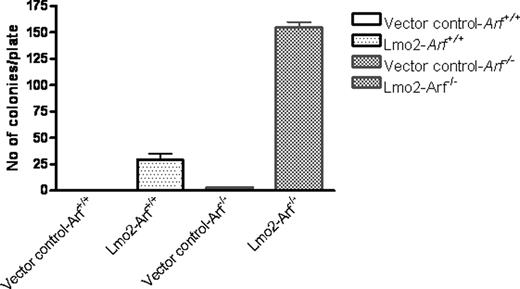Abstract
Abstract 47
Lmo2 overexpression and Arf loss induce myeloid differentiation in primitive thymocytes
LMO2 is a hematopoietic transcription factor that is deregulated as a consequence of chromosomal translocations in T-cell leukemia. Recently we reported that Lmo2 overexpression collaborates with loss of the p19Arf tumor suppressor to induce central T cell leukemias in mice, in part by conferring an increase in self-renewal and engraftment potential in thymic repopulating cells (Treanor LM et al, Blood 2011). Primary recipients were transplanted with Lmo2-transduced, Arf−/− DN2 (CD4−CD8−CD44+CD25+) thymocytes that were cultured on OP9-DL1 cells for 20 days before transplant. Primary recipients engrafted and secondary transplants were later performed. Several secondary recipients developed acute myelogenous leukemia originating from the thymocyte graft. These mice had elevated white blood counts between 200–500×103/μl and their spleen, thymus, bone marrow and peripheral blood contained 90% mCherry+, Gr1+, Mac1+ cells. Both the spleen and liver were infiltrated with myeloperoxidase positive blast cells and pathological review confirmed acute myeloid leukemia. Tertiary irradiated hosts transplanted with these cells developed a Gr1+ tumor with the same phenotype as the secondary animal. All of the tumor cells observed had a high expression level of the mCherry vector indicating that Lmo2 was expressed in the blast cells. Vector integration site clonality analyses confirmed that the vector was present in the blast cells and was from the same clone in the primary, secondary and tertiary recipient. This data led to the hypothesis that enforced Lmo2 expression and Arf loss may reprogram DN2 thymocytes to obtain myeloid differentiation potential. Transduced DN2 thymocytes were then assayed for myeloid colony formation in semisolid cultures containing cytokines that are specific for myeloid differentiation. Initially CD4−CD8− thymocytes were selected from Arf+/+ and Arf−/− thymi, transduced with either control vector or Lmo2 and cultured on OP9-DL1 stromal cells for 20 days. At day 20 the thymocytes were sorted for the vector positive DN2 population and 5×104 of these DN2 thymocytes were plated into these semisolid cultures. Only thymocytes that contained the Lmo2 vector were able to form myeloid colonies and this colony forming ability was greatly enhanced by the absence of Arf (n=3) as shown in figure 1. Moving to an in vivo assay, sublethally irradiated Rag2−/−γc−/−were transplanted with 2×105 transduced DN2 thymocytes. Three weeks after transplant the spleen, bone marrow and peripheral blood contained greater than 50% mCherry+ cells and of these cells between 3%-10% were Mac1+Gr1+ double positive. Vector+ (mCherry+) cells were sorted from the bone marrow and plated in semisolid culture with myeloid cytokines. After seven days the cultures were positive for myeloid colonies that were mCherry+, Gr1+, Mac1+. These in vivo and in vitro assays demonstrate that Lmo2 induces myeloid potential in DN2 thymocytes. These data indicate that Lmo2 expression combined with loss of the Arf locus may recapitulate a hematopoietic stem cell (HSC) “state” in the DN2 thymocytes as HSCs express relatively high levels of Lmo2 and do not express p19Arf due to Bmi1-mediated epigenetic suppression. The novel reprogramming events that we now report could have relevance to early thymic precursor leukemia, in which various degrees of myeloid conversion are noted. We recently documented high amounts of Lmo2 mRNA expression in pediatric early thymic precursor leukemia by expression array analysis in 11/12 cases.
Disclosures:
No relevant conflicts of interest to declare.
Author notes
*
Asterisk with author names denotes non-ASH members.
© 2011 by The American Society of Hematology
2011


